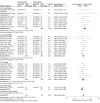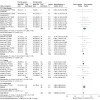Association of Music Interventions With Health-Related Quality of Life: A Systematic Review and Meta-analysis
- PMID: 35315920
- PMCID: PMC8941357
- DOI: 10.1001/jamanetworkopen.2022.3236
Association of Music Interventions With Health-Related Quality of Life: A Systematic Review and Meta-analysis
Abstract
Importance: Increasing evidence supports the ability of music to broadly promote well-being and health-related quality of life (HRQOL). However, the magnitude of music's positive association with HRQOL is still unclear, particularly relative to established interventions, limiting inclusion of music interventions in health policy and care.
Objective: To synthesize results of studies investigating outcomes of music interventions in terms of HRQOL, as assessed by the 36- and 12-Item Health Survey Short Forms (SF-36 and SF-12).
Data sources: MEDLINE, Embase, Web of Science, PsycINFO, ClinicalTrials.gov, and International Clinical Trials Registry Platform (searched July 30, 2021, with no restrictions).
Study selection: Inclusion criteria were randomized and single-group studies of music interventions reporting SF-36 data at time points before and after the intervention. Observational studies were excluded. Studies were reviewed independently by 2 authors.
Data extraction and synthesis: Data were independently extracted and appraised using GRADE criteria (Grading of Recommendations, Assessment, Development, and Evaluations) by multiple authors. Inverse-variance random-effects meta-analyses quantified changes in SF-36 mental and physical component summary (respectively, MCS and PCS) scores from preintervention to postintervention and vs common control groups.
Main outcomes and measures: SF-36 or SF-12 MCS and PCS scores, defined a priori.
Results: Analyses included 779 participants from 26 studies (mean [SD] age, 60 [11] years). Music interventions (music listening, 10 studies; music therapy, 7 studies; singing, 8 studies; gospel music, 1 study) were associated with significant improvements in MCS scores (total mean difference, 2.95 points; 95% CI, 1.39-4.51 points; P < .001) and PCS scores (total mean difference, 1.09 points; 95% CI, 0.15-2.03 points; P = .02). In subgroup analysis (8 studies), the addition of music to standard treatment for a range of conditions was associated with significant improvements in MCS scores vs standard treatment alone (mean difference, 3.72 points; 95% CI, 0.40-7.05 points; P = .03). Effect sizes did not vary between music intervention types or doses; no evidence of small study or publication biases was present in any analysis. Mean difference in MCS scores met SF-36 minimum important difference thresholds (mean difference 3 or greater).
Conclusions and relevance: In this systematic review and meta-analysis, music interventions were associated with clinically meaningful improvements in HRQOL; however, substantial individual variation in intervention outcomes precluded conclusions regarding optimal music interventions and doses for distinct clinical and public health scenarios.
Conflict of interest statement
Figures




References
-
- Centers for Disease Control and Prevention . Health-related quality of life (HRQOL). Centers for Disease Control and Prevention website. Reviewed June 16, 2021. Accessed December 2, 2021. https://www.cdc.gov/hrqol/index.htm
-
- United Nations . 2030 Agenda for Sustainable Development. United Nations; 2015.
-
- World Health Organization . What is the evidence on the role of the arts in improving health and well-being? A scoping review. World Health Organization; Regional Office for Europe; 2019. - PubMed
Publication types
MeSH terms
LinkOut - more resources
Full Text Sources
Other Literature Sources
Miscellaneous

